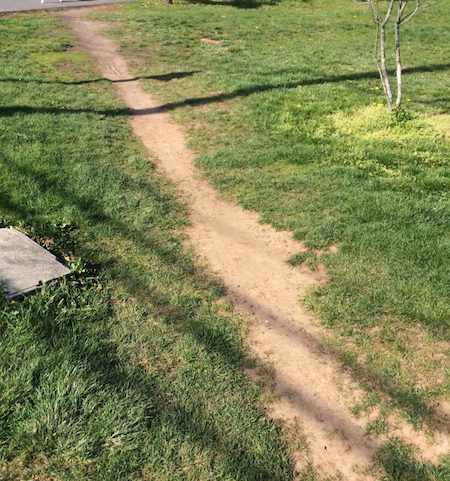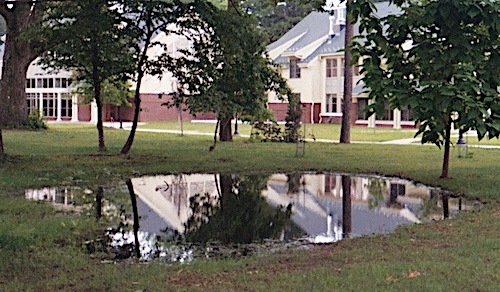Compacted Soil, Flood Damage and Distressed Trees
by Nisha Sensharma, Fairfax Master Gardener Intern

Compacted soil on footpath
Urban and suburban homes face increasing risk of flood damage due to torrential rain and vast areas of hard or impervious surfaces. Many homeowners take pride in their landscape efforts but may be discouraged when plants fail to thrive. What might these two problems have in common? Quite possibly, compacted soil. These problems lead to unnecessary costs incurred by the homeowner and harm to the environment.
Planting more trees and other plants is more important than ever. Plant roots prevent erosion and serve an important function in managing flooding and combating climate change. While many local governments are engaged in greening efforts, one study conducted in Boston found that urban street trees tend to have shorter lives than trees in rural areas. There are many reasons for this, but early risk of death for urban trees is attributed to difficulties in initial root development and access to water, both of which can be related to compacted soil.

Effects of compaction on pore space
When it comes to urban flooding, it is easy to see how hard surfaces like buildings and roads contribute to water runoff. The connection between compacted soil and water runoff is less obvious. Soil compaction makes soil less porous, making it harder for air and water to permeate, increasing runoff. Plants, especially trees with larger root systems, may not thrive in compacted soil. Without plants to hold soil in place, erosion and runoff worsen.
Let’s begin by looking at the difference between healthy soil and compacted soil. Soil consists of equal measures of solid material and open space. Solid material includes minerals (45 to 48 percent) and organic matter (2 to 5 percent). The rest is air and water. Compaction occurs when soil particles are pushed close together and lose pore space. In dry conditions, soil compaction may help plant growth up to a point, by promoting seed-to-soil contact and increased water to plant roots. However, in wet weather, soil compaction can prevent oxygen and nitrogen from reaching plant roots, causing distress to plants.
What leads to soil compaction and how can we avoid it? An important culprit is mechanical force caused by excessive foot traffic and vehicles. A study of lawns in Arlington County, VA, found that the average density of soil in new residences (i.e., compaction) was greater than that of soil in comparable older residences. This may explain flooding issues in newly constructed homes, possibly caused by heavy construction machinery.

Ponding water from poor infiltration and compaction
Solutions to the issue of soil compaction range from actions we can take as individuals and actions that local governments can take to prevent and remedy compaction. Here’s what you can do as an individual:
Examine your yard and look for areas that show eroded surfaces and exposed tree roots. Compacted soil can physically prevent tree roots from penetrating the soil, making them less stable. Note however, that certain trees have naturally shallow root systems.
Check to see if the soil is too hard (compacted) by pushing a wire flag. If it can penetrate 12 inches (30 cm), you can assume that the soil is not compacted. If the wire bends at less than 4 inches (10 cm), you know that you should take steps to address the compaction. You can also use a penetrometer for a more accurate assessment.
To preserve uncompacted or fair soil, add organic matter in the form of compost, cover crops or yard waste, being sure to add both brown and green components (e.g., shredded dry leaves and green lawn clippings). Green manures such as rye grass prevent erosion and fix nitrogen into the soil. Organic matter breaks down to provide important soil nutrients in addition to improving the soil structure, making it less compacted. For seriously compacted soil, you may need to add 2 to 3 inches (5 to 5 cm) of organic matter for several years and plant cover crops until the soil is improved. If the terrain is rocky, raised beds with pockets of soil and planting can be a starting point.
Plant strategically. Plants absorb water while filtering pollutants. Select plants wisely by prioritizing those that will grow well in your area and the specific conditions in your yard. Place water loving plants in areas where water tends to accumulate or run off. You could even consider installing a rain garden. This landscape solution can be used to divert water away from your home, preventing flooding. Adding mulch regularly will help to continually improve soil structure while providing nutrients to keep your plants thriving.
When it comes to policies, local governments in our region have implemented measures to protect stormwater quantity and quality. Fairfax County has a Private Residential Outreach Packet for homeowners and has several ongoing watershed improvement plans, projects and restorations. Arlington County requires additional de-compaction and amendment procedures on all new single family home projects (2021). The City of Falls Church charges a Stormwater Utility Fee while allowing homeowners to get credits for implementing water-wise practices like reducing impervious surface, installing rain gardens, cisterns and planting trees.
Take action. Make changes to improve soil structure on your own property and advocate for county-wide measures to prevent urban flooding, increase our tree canopy and support our wildlife.
- Resources
- Best Management Practice Fact Sheet 4, Soil Restoration, Virginia Cooperative Extension
- Building healthy soil with best management practices, Virginia Cooperative Extension
- Soil Compaction, University of Minnesota Extension
- Effects of Soil Compaction, Penn State Extension
- Stormwater Credits, Falls Church, VA
- What To Do About Compacted Soil, Michigan State University Extension
- Stormwater Maintenance and Inspection, Private residential outreach packet, Public Works and Environmental Services, Fairfax County, VA